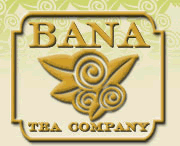
WELCOME!
ABOUT BANA
A LETTER FROM LINDA LOUIE
AN OVERVIEW OF TEA
THE SIX CLASSIFICATIONS OF TEA
DEFINITION AND HISTORY OF PU-ERH TEA
CHINA'S SECRET BREW
THE LEGEND OF PU-ERH TEA
TWO TYPES OF PU-ERH
HOW PU-ERH IS MADE AND STORED
CULTIVATION & HARVEST
MAKING RAW AND RIPE PU-ERH TEA
TEA CAKES: PRESSING, PACKAGING, OPENING
PROPER PU-ERH STORAGE
Bana Tea Company hopes to enhance your Pu-erh experience by providing information on the history of Pu-erh tea, the art of tea brewing, and the intricacies of Pu-erh cultivation, harvesting, drying, aging, curing, & storing. For information about the philosophy and origins of Bana Tea Company, please see About Bana. And please take a moment to read A letter from Linda Louie, tea purveyor and owner of Bana Tea Company.
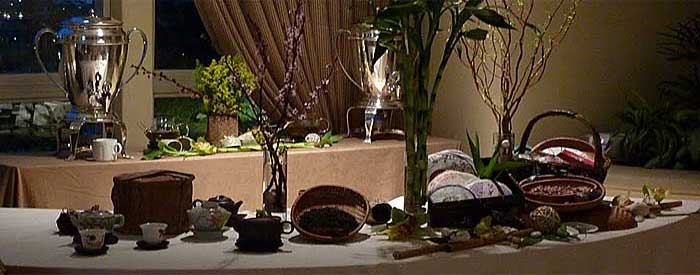
DEFINITION & HISTORY OF PU-ERH TEA
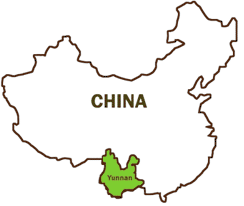 CHINA'S SECRET BREW
CHINA'S SECRET BREW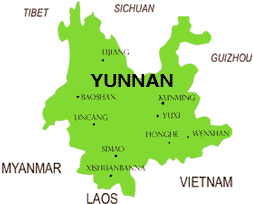
Pu-erh - The Tea that Ages Like Wine
High in the mountains of Yunnan, China, in an area believed to be the birthplace of tea some 4700 years ago, there are groves of ancient tea trees. These trees, some as old as 1700 years, flourish naturally under pristine temperate conditions. They are primarily cultivated, tended and harvested by the Chinese ethnic minority groups called Bulang, Dai and Hani tribal groups.
These tea trees are of a broad leaf version of the tea plant (Camellia sinensis var. assamica) native to the southwest region of Yunnan China (Yunnan Dayeh). Because of the inherent qualities of these leaves, the tea does not lose its flavor with time like other teas. Instead, like wine, Pu-erh tea's taste improves with each passing year, becoming more flavorful, more complex and more mellow. It is perhaps because of this singular feature, the capacity to improve with age, that Pu-erh is also called "a drinkable antique." High quality Pu-erh is in short supply as it is coveted and hoarded by tea connoisseurs in China and Asia. Relatively small amounts of good Pu-erh are left for shipment to tea lovers in the West. Indeed, Pu-erh is a secret treasure yet to be discovered for many outside of Asia.
THE LEGEND OF PU-ERH TEA
According to historical accounts, sometime during the Tang Dynasty (AD 618-907), merchants began packing these large tea leaves into compressed cakes. These cakes of tea were easier to transport by pack animal than cumbersome loose-leaf tea. Because of the long distances and difficult terrain, it would be months before the tea would reach its destination, whether that would be Tibet, India or faraway Beijing. Something miraculous occurred during the extended delivery periods and the varying climatic conditions: the tea changed. Not only did the color of the tea transform from green to dark teak, but also the taste of the tea became livelier, richer and smoother. During its months of travel, the tea underwent a fermentation process whereby microbes acted on the tea, causing biological and enzymatic changes. The resulting tea, known to Chinese as Pu-erh, became highly sought after, first by royalty, high officials and the literati, and later by tea connoisseurs. (see our ARTICLE on pressing tea cakes) (see our VIDEO on pressing tea cakes)
Pu-erh tea is named after a town called Pu-erh located in central Yunnan. Pu-erh did not produce tea; rather, it was a trading post where all teas produced from the nearby tea mountains were sold and traded. For easy transport, teas were compressed into cakes or bricks and transported to different parts of China and Asia by horse caravan. Later, all teas traded in this town came to be known as Pu-erh tea.
TWO TYPES OF PU-ERH
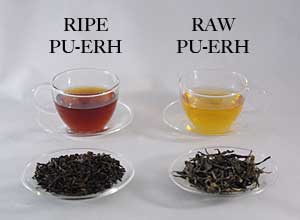 While most teas, by and large, are best consumed soon after production to retain both their aroma and flavor, Pu-erh can be aged and refined like wine. It undergoes a fermentation process (either naturally or artificially) where microbes act on the tea leaves over time, causing the leaves to darken and the flavor to change to become smoother and more complex. Depending on the conditions and the environment of aging, the taste can transform through various stages, from being fruity, floral, grassy, to being earthy, woody and nutty.
While most teas, by and large, are best consumed soon after production to retain both their aroma and flavor, Pu-erh can be aged and refined like wine. It undergoes a fermentation process (either naturally or artificially) where microbes act on the tea leaves over time, causing the leaves to darken and the flavor to change to become smoother and more complex. Depending on the conditions and the environment of aging, the taste can transform through various stages, from being fruity, floral, grassy, to being earthy, woody and nutty.
There are two major types of Pu-erh tea: "Raw Pu-erh" and "Ripe Pu-erh". These two Pu-erh types are distinguished by their respective fermentation processes. Both types of Pu-erh are made from the same raw materials (mao cha) - freshly harvested leaves that have been wilted, either fried manually or tumbled through a heated rotating cylinder, kneaded and sun dried in open air. The term "Raw Pu-erh" refers to loose leaves, tea cakes or bricks made from raw materials without additional processing. Raw Pu-erh can be consumed immediately to enjoy its fresh, floral or fruity flavors, or it can be left to age in a natural environment to achieve a mellower, smoother and more complex flavor. Naturally aged Raw Pu-erh teas, particularly those made from premium raw materials, are the most sought-after by tea connoisseurs.
"Ripe Pu-erh" offers an alternative to having to wait ten to thirty years for the Raw Pu-erh to mature and achieve the aged flavor that is popular among many Chinese. In the 1970's, the industry developed a method to artificially accelerate the aging process by "cooking" Pu-erh tea. This "cooking" process, called "wo dui", involves incubating the tea in a moisture-rich environment where microbial activity causes the temperature to rise, drastically intensifying the fermentation process. This process typically takes a few months to complete.
Here are some comparisons between a raw and a ripe Pu-erh:
Time required to achieve full fermentation:
Raw: 20-30 years.
Ripe: A few months.
Taste differences:
Raw: Young raw Pu-erh shares similar characteristics as green tea. As the tea ages, it becomes more complex and is famous for its stronger mouth sensation and long-lasting aftertaste.
Ripe: Earthy and mellow. Aged ripe Pu-erh becomes smoother and the earthy flavor transforms into sweet plum flavor.
See Taste Profiles of Raw and Ripe Pu-erh Teas
Color of the brew:
Raw: Golden yellow to burnt orange, depending on the age of the tea
Ripe: Dark chestnut Appearance of the leaves: Raw: The brewed leaves of raw Pu-erh are more intact, plump and soft. Ripe: The brewed leaves of ripe Pu-erh are generally broken, black in color and no longer soft.
Whether fermented naturally or manually, studies have shown that the microbial activity in Pu-erh tea offers probiotic health benefits that no other teas offer.
Determining the quality of Pu-erh tea requires some basic knowledge and experience. The quality of Pu-erh tea is based on a number of factors: area of production, leaf source, the grade of the leaves, methods of cultivation, the time of year it is harvested and the conditions under which it is stored.
Area of production:
Good quality Pu-erh tea comes from the four major Pu-erh producing regions in Yunnan, namely Simao, Xishuangbanna, Boshan, and Lincang. There are 10 famous tea mountains, six of them located within Xishuangbanna. Some of the most famous tea mountains today are: Yiwu, Jingmai, Nannuo, Yibang, Banzhang, and Yibang.
Leaf source:
Pu-erh teas can be made from leaves harvested from old arbor tea trees (qiao mu), sustainable farming small trees (Shengtai), tea bushes (guan mu) or wild tea trees (Yehsheng). The best leaf source is from the old arbor tea trees, followed by the wild trees, sustainable farming small trees and lastly tea bushes.
The old-growth arbor trees are the most genetically diverse as they are planted by seeds rather than by cloning. Consequently, teas made from these trees are richer, more complex, and offer good cha chi (positive energy) as compared to the clonal variety. Furthermore, the old arbor trees have been thriving on their own without human intervention for centuries, never requiring fertilizers or pesticides. Selena Ahmed, Ph.D., discovered in her research that leaves from the old arbor trees possessed the most anti-oxidants. She theorized that the old tea trees have to work harder to fend off pests and other herbivores and develops these compounds in response. To view Dr. Ahmed’s study, please see http://onlinelibrary.wiley.com/doi/10.1111/j.1755-263X.2012.00269.x/abstract
The demand for tea made from old trees is high but the yield of old tea trees is small. To meet the high demand, tea manufacturers sometimes mix the leaves from old trees with the leaves from tea bushes and pass them off as old tree teas. The ability to distinguish characteristics of different leaf sources is crucial to avoid being cheated. For information on how to tell if the tea is from the old trees or not, please click here: "Is it from the old trees of not?"
This is not to imply that all Pu-erh tea made from the bushes are inferior teas. However, teas made from bushes do not call for the high prices as do teas made from the old trees. Therefore, knowing the above-described characteristics will hopefully enable consumers to avoid over-paying for their tea purchases.
Season of harvest:
Pu-erh is harvested during spring, summer and autumn. New buds break in late March before the first rain. The first spring harvest is called Ming Qian Tea, referring to teas harvested before the Chinese Qing Ming Festival. Ming Qian Tea is considered the finest and most prized crop of the year’s production. The leaves are then picked two more times before the monsoon season. Leaves harvested in autumn are generally second to the spring harvest but superior to the summer harvest in quality.
Grades:
Pu-erh can be categorized into ten grades, from one to ten. The grades are determined by the time of harvest, the amount of buds, freshness of the leaves. The lower numbers represent young leaves closer to the bud and the high numbers represent older leaves farther down the branch. A bud and two leaves are considered the most desirable combination. Many tea cakes feature a blend of several grades to attain a desired flavor. This blending is usually disclosed by the tea producer. In other cases, there may be less benign reasons for producers to blend several grades of tea together.
Storage Conditions:
The aging of Pu-erh tea requires proper temperature and certain amount of humidity. However, a storage environment that has excessive heat and humidity often adversely affects the quality of the tea. Properly stored Pu-erh tea should be fragrant, pure and smooth, and offer long lasting after-taste that coats the mouth and throat. Improperly stored teas often lack character, and some even have a sharp unpleasant smell.
Judging the leaf source of Pu-erh tea requires experience and a determination often may not be conclusive. As indicated earlier, many teas that claim to be from ancient trees are mixed with leaves from bushes. Teas made from truly ancient trees are hard to come by and require a trusted producer to employ very strict quality control in their production.
return to the top of page
TASTE PROFILE OF A RAW PU-ERH
Raw Pu-erh made from old-growth arbor trees possesses an array of aromas and flavors. The most common are camphor, lotus, orchid, dried jujube, dragon eye (longan) fruit, plum, ginseng, and areca. The different taste profiles in Pu-erh have to do with the grade of the leaves, the stages of aging, and the other types of trees that are grown in the general area. As the old-growth arbor tea trees have very deep roots, over time, the roots of the tea trees would intertwine with the roots of other forest trees nearby and absorb the fragrance emitted from the other trees.
Sometimes, the taste profile will transform from one flavor to another in between brews of the same tea or one may experience a bouquet of flavors within a single brew. Many Pu-erh aficionados would agree that the best taste is obtained at around the 4th or 5th brew, when the leaves are totally unfurled and the flavors are released.
Bana offers a Raw Pu-erh Sampler with of seven of our best raw teas including our very popular Purple Tip and Moonlight White.
TASTE PROFILE OF A RIPE PU-ERH
As ripe Pu-erh has undergone full fermentation, much of the bitterness and astringency inherent in the tea leaves have dissipated. Ripe Pu-erh is generally earthy, nutty or woody. Good quality aged Pu-erh should be mellow, smooth and offer a sweet (sugarcane or plum) aftertaste (hui tian). Poor quality ripe Pu-erh is flat, dull, thin and may have an unpleasant odor.
Bana offers a Ripe Pu-erh Sampler for an overview of six premium ripe teas including our best sellers.
Bana also offers a Variety Pu-erh Sampler for an overview of both raw and ripe teas including 3 of our best sellers.

Other Ways to Enjoy Pu-erh Tea:
Pu-erh tea can be consumed by itself or mixed with flower teas, such as rose, osmanthus, or chrysanthemum. Flowers add a nice floral aroma and taste that makes the tea more interesting and enjoyable. Goji berries, high in antioxidants, may also be added to serve as a natural sweetener. In warmer weather, clients have reported that cool Pu-erh can be very pleasant and refreshing.
I encourage you to try and experiment different combinations to make your tea drinking experience more interesting and rewarding.
The following retailers carry select varieties of Bana Teas:
Happy Luckys Tea House - 236 Walnut Street, Fort Collins, CO 80524
High Mountain Tea - 160 Baldwin St, Toronto, ON M5T 3K7, Canada
Tin Roof Tea - 419-B Daniels Street, Raleigh, NC 27605
Cultured Cups - 13714 Gamma Rd., Ste., 104, Dallas, TX 75244
PU-ERH TEA FAQs
Below are some answers to Frequently Asked Questions about Pu-erh tea. (click here to download the Pu-erh Tea FAQ Sheet PDF)
